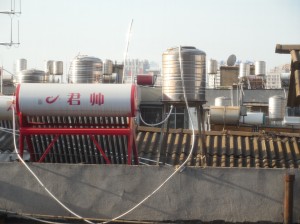My first exposure to China’s climate policy position was at COP 17 in Durban, So. Africa. There I asked a Chinese delegate if shale gas would be in the mix of transition fuels to wean China off coal in order to ameliorate the air pollution which continues to be a major contributor to a growing public health problem in eastern China. His response was that shale gas was a minor resource in China and that coal would continue to be a major player in energy production. Clearly the implication was that China was not interested in resolving the air pollution that chokes major cities as much as the continuation of the pace of economic development that was rapidly bring China into the 21st century as a developed nation. This was not what I was hoping for at a climate change conference.
What a difference three years makes! Since COP 17 and over the past year I have spent a month exploring Yunnan Province in southwestern China looking at sustainability efforts through alternative energy and climate change effects on agriculture and water availability. While you see the reason their CO2 emissions are so high (construction of high rises with no tenants, multi-lane highways to small towns, and long rail and highway overpasses to avoid farmers fields and the energy needed to build all this) even in the relatively cleaner western parts of China, there is a sense that this pace of development is not sustainable if for not other reason then the environmental degradation it is causing to some very beautiful landscapes. Moreover a lingering drought has this mostly agrarian part of China reeling from lack of rain especially for rice production. Climate change may be taking hold and the Chinese sense it.
So what has changed? While we are not sure exactly what the China’s strategy will be, it is clear they want to slow the use of coal to improve the air quality of the major cities at the very least. We saw lots of reasons to believe that alternative, non-fossil fuel energy is being used especially at the personal level. In the large cities and small villages as well solar hot water is the name of the game. In Kunming, the provincial capital, every rooftop has a solar water heater; even apartment buildings string a dozen or two water heaters together to supply all the tenants. Biogas has become a staple of rural energy life in place of burning scare wood. And government officials at the local level are encouraging these changes.
So what can we expect from the Chinese at COP 20 where they will be even a bigger player in the negotiations than they were in Durban? It is hard to know as one is never quite sure what they will come up with and how they will approach climate change mitigation now. But from talking to the people in Yunnan province including the scientists doing biomass and solar heating research it appears that the Chinese are beginning to see the value of slowing development, encouraging well established alternative energy sources at the local level, and becoming more concerned about a pending public health crisis in their megacities. Will the Chinese find a way not only to play nice with the other “kids” in Lima but also be a positive influence in solving global emissions problems? Stay tuned.


This seems like a very difficult situation for China. If they want to continue to grow economically (which means high energy demands) and don’t have any energy resources that are readily available besides coal, it seem next to impossible for them to clean up their city air. It is a great thing that they are already using solar hot water, but it seems hardly enough in the face of the smog they face. Is there a way that they can still develop economically without choking themselves? Is nuclear on the table for them?
Hi Will – The problem is that they are developing so fast that nuclear plants cannot be built fast enough to keep up. They are still building coal-fired plants but less than before. They have to keep the energy coming but also deal with the pollution which they recognize is a public health nightmare looking for a place to happen and it will. the solution is more alternative energy (wind and solar, where possible; biogas in the rural areas but that is small potatoes so far) and hydro and hopefully coming soon, more natural gas. They have already dammed up many rivers and that has unintended consequences (i.e. Three Gorges is filling with sediment rapidly). They probably have natural gas and shale gas in the Sichuan and Qinghai provinces but infrastructure and technology lag here. They haven’t figured out horizontal drilling yet. Alternatively they are buying up large natural gas deposits in Mozambique (maybe third largest field in the world) and shipping it. They are slowing their purchase of coal from Australia. So they have alternative in energy and also conservation means to slow the input of CO2 and particulates into the air but it wil take a while to do that. On the other hand a communist governance state can dictate changes more quickly than a democracy so if they go that way it will be relatively rapid. They are also toying with cap and trade so who knows what exactly will happen. I think it will be interesting to follow the Chinese delegation closely in Lima to see what they do and don’t do.